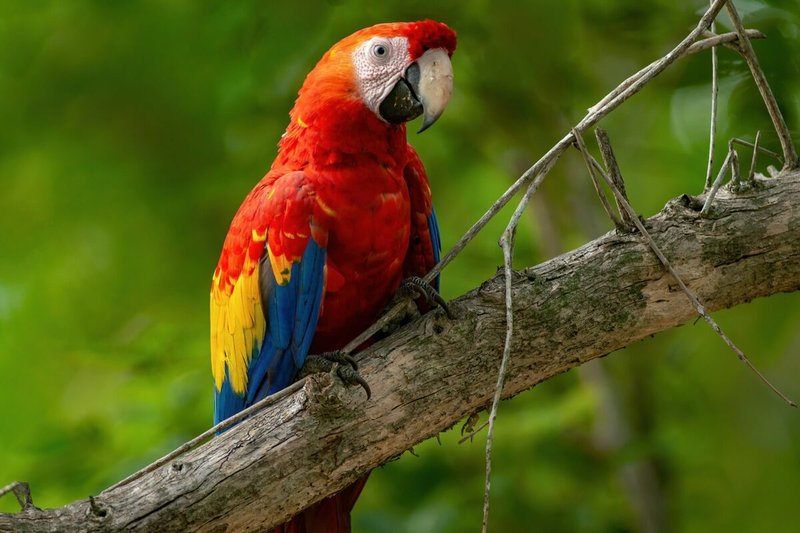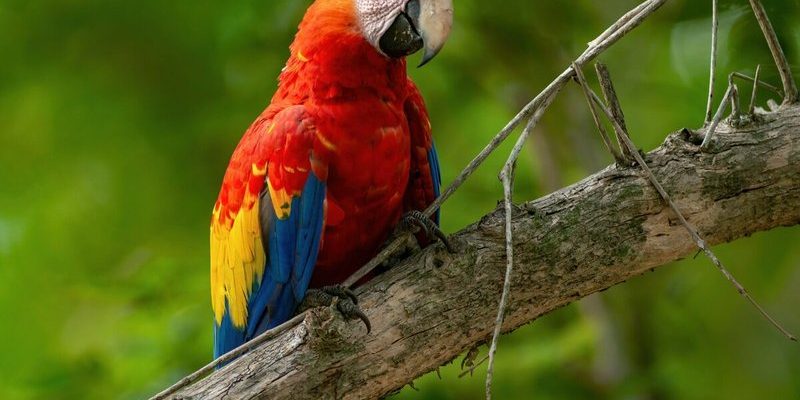
So, how do you spot one of these magnificent creatures when you’re out in the wild? Well, it’s not just about luck; it involves a bit of knowledge. By learning some key traits and behaviors, you can increase your chances of seeing these stunning birds and appreciate them even more. Let’s dive into what makes the scarlet macaw so special and how you can identify one if you’re lucky enough to come across it.
What Do Scarlet Macaws Look Like?
Scarlet macaws are famous for their stunning appearance. These birds showcase bright red feathers on their bodies, contrasted by stunning yellow and blue feathers on their wings. When they take flight, it’s as if a rainbow is soaring through the sky. But wait, there’s more!
– Body Size: Scarlet macaws are large birds, often measuring about 33 inches in length, including their long tail feathers. Their impressive wingspan can reach up to 4 feet, making them quite a sight when they glide through the air.
– Beak: One thing you can’t miss is their powerful, curved beak, which is a dark horn color. This sturdy beak is designed for cracking nuts and seeds, their primary food source.
– Eyes: They have bright white eye patches around their eyes, which add to their striking look. Their eyes themselves are usually a light-colored shade, helping them stand out even more.
When you spot a scarlet macaw, take a moment to enjoy the sheer beauty of it. It’s not just about the colors; it’s also about the shape and size that make them unforgettable.
Where Are Scarlet Macaws Found?
Scarlet macaws are native to the tropical rainforests of Central and South America. You’ll find them in countries like Costa Rica, Brazil, and Panama, happily swinging from tree to tree. If you’re planning a trip to see one, here are a few places you might want to visit:
– Rainforests: These birds thrive in humid, dense forests, often nesting high in tall trees. They typically favor areas with plenty of fruit-bearing trees, as fruits make up a huge part of their diet.
– Flooded Forests and Swamps: Interestingly, scarlet macaws can also be found in flooded areas of the forest. They adapt well to various habitats, which helps them survive.
– National Parks: Places like Corcovado National Park in Costa Rica or Yasuni National Park in Ecuador are excellent locations to glimpse these beautiful birds in their natural habitats.
You might be wondering how to spot them in such vast surroundings. Look for the bright colors in the treetops or listen for their loud calls, which can echo through the forest. Trust me, once you know what to look for, spotting them becomes a thrilling adventure!
Observing Their Behavior
Identifying a scarlet macaw isn’t just about what they look like; their behaviors also tell you a lot. Here’s where it gets fun. These birds are social creatures and often travel in pairs or groups, which adds to the charm when you see them flying together.
– Flying: When a group of macaws takes off, it’s a spectacle! They flap their wings vigorously, often creating a loud, raucous noise. Watching them soar is exhilarating, and you can often hear their chatter before you see them.
– Eating: If you spot a macaw munching on nuts or fruit, don’t be surprised if they make quite a mess! They often use their powerful beaks to crack open hard shells, sending bits flying everywhere.
– Social Interactions: Scarlet macaws are known for their playful nature. You might see them grooming each other or engaging in playful fights. This behavior is not only essential for bonding but also showcases their lively personalities.
Keeping an eye on their social dynamics can help you appreciate their fascinating world. Imagine witnessing a playful chase among them; it’s like watching a mini-drama unfold high in the trees.
Listening for Their Unique Calls
Scarlet macaws are as loud as they are colorful. Their vocalizations are a critical part of their identity and can be a significant clue when you’re trying to identify them.
– Calls: They have a series of distinct, high-pitched calls that sound like “squawks” or “kak” sounds. This calling helps them communicate with each other, especially when they’re flying. If you hear these loud and echoing calls, you’re likely in scarlet macaw territory.
– Mimicry: These birds are also known for their ability to mimic other sounds, though they mainly have their unique set of calls. It’s a great way for them to express emotions or signal danger.
By tuning in to their sounds, you can locate them much easier. It’s like having nature’s radar guiding you toward these vibrant aviators.
Knowing Their Nesting Habits
Scarlet macaws have some interesting nesting habits that can help you identify where they might be living. Typically, they build nests in tree cavities, which provide safety and shelter for their young.
– Nesting Sites: They prefer high, sturdy trees that can offer protection from predators. If you’re exploring an area where there are large trees, keep an eye out for any activity around those branches.
– Breeding Season: Their breeding season usually runs from December to March. During this time, you might notice increased activity near nesting sites, with both parents working together to feed and protect their chicks.
– Chick Development: When the chicks hatch, they rely on their parents for food and protection. Watching this nurturing process can be a real treat for birdwatchers.
If you spot a nest, just remember to keep your distance. It’s essential to observe without disturbing their home, allowing them to raise their young in peace.
Conservation Status and Importance
Understanding the conservation status of the scarlet macaw can add depth to your birdwatching experience. Unfortunately, due to habitat destruction and illegal trapping for the pet trade, these beautiful birds face challenges in the wild.
– Threats: The primary threats to scarlet macaws include deforestation and hunting. As rainforests diminish, their habitat shrinks, making it harder for them to find food and shelter.
– Importance in Ecosystems: Scarlet macaws play a crucial role in their ecosystems. By feeding on fruits and nuts, they help disperse seeds, aiding in the growth of plants. This process is vital for maintaining the health of their habitats.
– Conservation Efforts: Many organizations are working tirelessly to protect scarlet macaws and their habitats. By supporting these efforts, birdwatchers can contribute to keeping these stunning birds flying high in the wild.
Being aware of their conservation status not only enhances your appreciation for scarlet macaws but also empowers you to be a part of the solution.
Final Thoughts
Identifying a scarlet macaw in the wild is like finding a hidden treasure. With their stunning colors, playful behaviors, and loud calls, they offer a vivid experience for any nature enthusiast. By understanding what they look like, where they live, and how they behave, you can significantly increase your chances of spotting them.
So, next time you venture into a tropical rainforest, keep your eyes peeled and your ears open. You might just catch a glimpse of those flashy feathers or hear their joyful calls echoing through the trees. Remember, every encounter with nature is a learning experience, so enjoy the journey and the beauty of the world around us!

